This website is supported by its readers. If you click one of my links I may earn a commission. I am also a participant in the Amazon affiliates program and I will also earn a commission from qualified purchases.
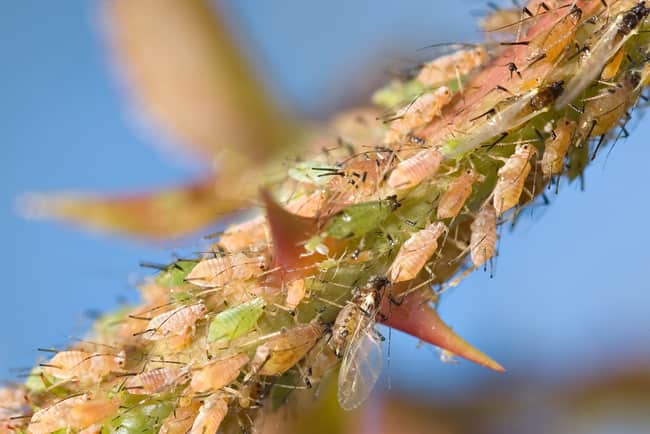
One of the things I was quite surprised at when I first started my bonsai journey, was just how many pests my bonsai trees attracted – even if I kept them indoors. Scale, fungus gnats, and spider mites all being common occurrences. One of the most common insects to attack my growing bonsai nursery however has been aphids. So how exactly do you remove Aphids on bonsai?
Using a mixture of two tablespoons of liquid soap with 30 oz of water and spraying your bonsai leaves is the most effective way to remove aphids from your bonsai. Alternative methods include using neem oil, blasting your bonsai with water, and investing in predatory insects that eat aphids.
So which of these methods are the most effective? And how exactly can you tell if you have aphids attacking your bonsai? Keep reading to find out more!
Just a quick heads up, over the past three years of running Plantpaladin, hundreds of people have asked for product recommendations. As such, You can find my favorite indoor bonsai tree here (link takes you to Bonsaiboy), my favorite outdoor bonsai tree (link takes you to Bonsaiboy), or have a look at all the products I recommend here.
How to get rid of aphids from your bonsai tree?
Whilst you might not think having an aphid infestation on your bonsai will ever happen to you, the truth is it is only a matter of time before Aphids and other creepy crawlies start to nest in your bonsai.
Even if you keep your bonsai tightly secured away in its own nursery, eventually, they will find a way to attack your plant.
Luckily, because aphid infestation is a common occurrence, there are several ways to remove them from your tree including:
- Using a mix of liquid soap and water in a spray
- Neem oil
- Rubbing alcohol and water
- Insecticide sprays
- Investing in parasitic insects
- Manually removing the bugs
- Using vinegar
- Water blasting
To help explain more I’ve put these in a table:
|
How to remove Aphid |
Method |
| Liquid soap and water | Mix two tablespoons of regular supermarket liquid soap with 30oz of water. Pour into a spray bottle and thoroughly spray the leaves of your bonsai |
| Neem oil | Pour a few drops of neem oil into a cotton ball or swap and thoroughly scrub the bonsai leaves and all hard-to-reach areas. |
| Rubbing alcohol and water | Use one cup of 70% rubbing alcohol and mix with 30oz of water in a bowl. Then either pour into a spray bottle or using cotton wool apply to all the bugs |
| Insecticide sprays | Move your bonsai into an outdoor open space and then spray thoroughly with the insecticide. Wait for the allocated time for your spray before bringing it back inside. |
| Parasitic insects | Lady beetles are the natural predator for aphids so introducing them where you keep your bonsai will naturally eat any aphids – once the aphids have been removed you can store the beatles somewhere else for your next removal. |
| Manually remove the bugs | Get a paper towel or scrap paper. Then manually tap the aphids until they fall on the paper. Aphids can also be removed by using a thick brush to rub your bonsai down with. |
| Vinegar | Mix one cup of water with one cup of vinegar and pour in a spray. Then thoroughly spray the bonsai to remove the aphids. |
| Water blasting | Place your bonsai outdoors. Then blast with water from a jet washer to blast the aphids away. |
Now each of these has its own specific methods that can be quite detailed.
If you’re a beginner, they can also be a little nerve-wracking so let’s break these down further below:
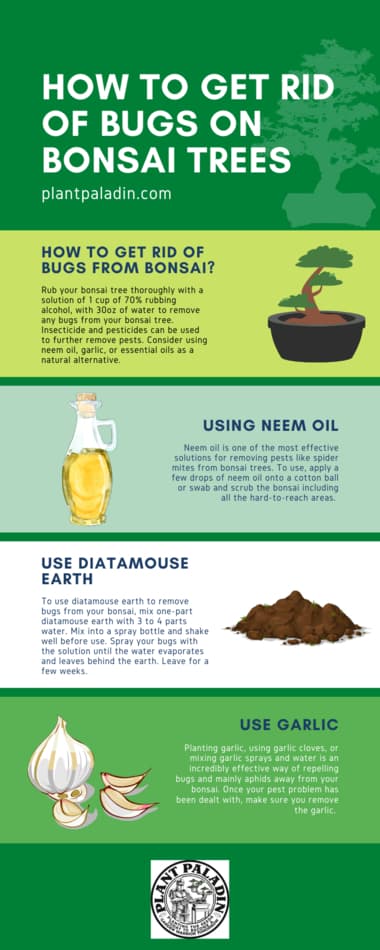
Soapy water to remove aphids from bonsai
Easily my favorite method of removing aphids from bonsai is just using a mix of soapy water and spraying your bonsai.
What I like best about this method is that it is relatively inexpensive.
It uses items that can be regularly found around the house.
Better yet as you will be using household items it leaves away no toxins and is not harsh to humans – just keep the spray away from your eyes.
To do this then:
- Move your bonsai away from the others in your collection so the other plants do not get infected.
- Fill a bowl with 30 oz of water.
- Fill another bowl with 2 tablespoons of liquid soap.
- Mix thoroughly.
- Pout into a nozzle spray bottle.
- Swab a small section of your tree with the spray at first to see if there is no reaction – you will need to wait 48 hours for this.
- If there is no reaction – spray your bonsai thoroughly. On and under the leaves, on the steps and apply a layer on the topsoil
- Wait 24 hours to dry.
- Then after 7 to 10 days redo the method to get rid of any eggs or aphids you missed.
This method works partially well in the 40 to 90-degree Fahrenheit range or (4 to 32 degrees Celsius) so is ideal to use from spring to fall.
Using the liquid spray will also wash away any sap on your tree, meaning it will be less likely that other aphids will nest as they are attracted to this sap.
How effective is it at removing aphids: 9/10
Neem oil to remove aphids
Another common and ancient method to remove aphids and other pests from bonsai is to use neem oil.
The neem tree has been used for multiple purposes not only in the Indian subcontinent but worldwide for almost 4500 years and so its properties work as a natural aphid killer.
Neem oil is one of the most effective solutions for removing pests like aphids from bonsai trees. To use, apply a few drops of neem oil onto a cotton ball or swab and scrub the bonsai including all the hard-to-reach areas.
Once your aphids have been removed, ensure you wash your bonsai to remove any excess oil that if left on for too long as it can damage your plant.
Why is neem oil good to use for aphid removal?
One of the reasons I love using neem oil is because it too is 100% natural.
It has been recognized by the likes of the EPA as a pesticide that does not cause any adverse effects in humans.
Neem oil is also OMRI listed, which is an accrediting body in the USA that lists only organic produce.
Neem oil won’t harm so-called good bugs like bees, only affecting aphids and other pests.
Top tips for using neem oil to remove aphids
Some top tips then for using neem oil would be as follows:
- Apply neem oil after sunset, as it can cause your plant to overheat if you do so
- Opt for a brand that is 100% organic, at around 70% concentration
- Ensure your neem oil contains Azadirachtin which is the active ingredient found in neem trees.
Now if you are interested in my recommendation for neem oil it would have to be the Harris Neem Oil (link takes you to Amazon) which has been 100% cold-pressed and is super easy to mix.
How effective is it at removing aphids: 8/10
Rubbing alcohol and water
Whilst it might not seem like it to us, rubbing alcohol is an incredibly powerful insecticide and is particularly effective against aphids.
Rubbing alcohol that is around 70% works best and dissolves the aphid’s outer shells.
How to use:
- Move your bonsai away from the other trees in your collection.
- Get 1 cup of 70% rubbing alcohol
- Fill up a bowl with 30oz of water
- Mix these items in a bowl
- Once mixed pour into a spray nozzle
- Spray your bonsai thoroughly, in all the hard to reach areas – your bonsai should be dripping wet
- Once completed let your bonsai soak for 24 hours
- The rubbing alcohol should kill off most of the bugs, however, if you find that there are still a few, you can repeat this process two or three times.
This method works incredibly well – that being said, as bonsai sometimes have hard-to-reach areas, I found that sometimes using cotton wool can be a more effective method.
How to use rubbing alcohol and cotton wool to remove aphids
- Pour 70% rubbing alcohol into a cotton ball
- Using this cotton ball, rub down each leaf, branch, and twig of your bonsai as well as all the hard to reach areas such as the underside of leaves
- Target the Aphids directly that are easy to spot
- Once completed, pour rubbing alcohol into a cotton swab to get into all the nooks of your plant which will be a lot easier than using a cotton ball
- Finish off by pouring the rubbing alcohol into a paper towel and wipe down the side of your plant pot which can be a breeding ground for insect eggs.
Studies have found that not only does this work again aphids but other bugs too so keep some in your pantry.
How effective is it at removing aphids: 8/10
Insecticide Sprays
Don’t get me wrong, pesticides and insecticides will remove and kill aphids from your bonsai.
The reason however why I’m a little hesitant to use these and want to opt for natural pesticides such as neem oil or rubbing alcohol is that they can drastically impact your plane health.
Using insecticides can affect the PH level of your soil and so can potentially interfere with the nutrient flow of the plant.
This can also prove dangerous to humans so ensure if using these chemical pesticides you use one that has been approved by the EPA
How do pesticides remove aphids?
Pesticides remove aphids by attacking the central nervous system of the bugs by releasing specific enzymes that affect them.
When choosing a pesticide I would select one that contains the following chemicals for best results against aphids:
- Diazinon
- Fenthion
- Malathion
- Methyl-parathion
- Sulfotep
- Trichlorfon
How to use a pesticide against aphids
- Ensure you wear thick gloves and a mask when using pesticides.
- Once sprayed ensure you are not present in the same room if treating your plant indoors.
- Follow the instructions exactly as dictated on your bottle – different pesticides need to be used in different ways.
- Air out any rooms thoroughly before going back into the room used for spraying your bonsai.
- Take your clothes off and wash them thoroughly once you have used the pesticide or insecticide.
- Wash your hands thoroughly after spraying.
Are there any natural pesticides that can remove Aphids?
Neem oil is the best natural pesticide you can use for aphids on bonsai. Neem oil stops larvae and egg development as well as inhibits aphids from mating. Once washed off, neem oil also benefits any fungal root issues that are common in bonsai.
How effective is it at removing aphids: 10/10
Parasitic insects to remove aphids
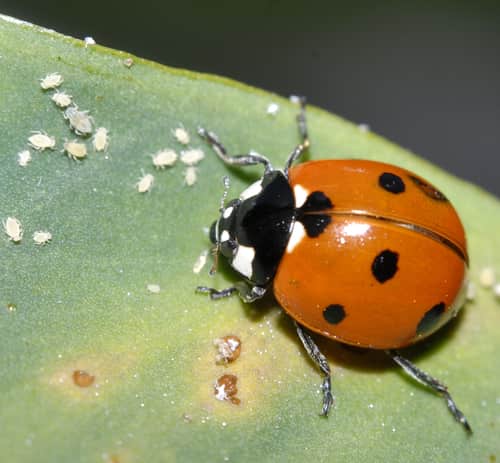
Another fantastic and natural option to help remove aphids from your tree is to invest in parasitic predatory insects that feast on aphids.
These insects will hunt down the pests and each of them without damaging or affecting your bonsai.
What insects work best to remove aphids?
Lady beetles (also referred to as ladybugs, ladybirds, or Hippodamia Convegens) are the best insect to help remove aphids naturally from your bonsai. Wasps and spider mites are also particularly effective at removing aphids.
According to SAREP the best method to using these bugs is a follows:
- Put the lady beetles in a refrigerator for a few hours during the day
- At nighttime release, the lady beetles to the bottom trunk or lowest branches of the bonsai
- The ladybugs will then climb the bonsai looking for aphids to eat
- In the morning collect the ladybugs
- Check the bonsai in 7 to 10 days, if there are still bonsai present release the ladybirds again.
Just be careful when you release these that there are no frogs or wasps present in your garden which pray on these ladybugs
How effective is it at removing aphids: 7/10
Manually removing aphids
Another method you can use to remove aphids would be to just manually remove them.
I find this method more cumbersome than effective however if you only have a small aphid infestation then it can work well for you.
To do this then:
- Use some sterile pliers and manually try picking the aphids up individually
- Alternatively, if the aphids are at the bottom of your leaves then tap the top of the leaves and the aphids will drop – use a piece of paper to catch these.
- Check your plant in one week for further signs of aphids and then repeat the process if need be.
How effective is it at removing aphids: 3/10
Using vinegar to remove aphids
Similar to using rubbing alcohol or liquid soap, vinegar also has properties that make it very effective at removing aphids from your bonsai.
What type of vinegar works best?
White wine vinegar or apple cider vinegar works best at removing aphids from bonsai. All vinegar however will work to some degree as the basic process is the same.
How to remove aphids from bonsai with vinegar
Mix 1 cup of vinegar with 1 cup of water in a spray bottle. Shake thoroughly and then spray your bonsai to remove aphids. White wine or apple cider vinegar tends to work best.
How effective is it at removing aphids: 6/10
Water blasting aphids
There is a reason I saved this method for last… mainly because it is easily the most fun method on the list.
Water blasting works by using something like a high-power jet wash or water with force to blast the aphids off of your bonsai.
What jet wash works best?
A typical household use pressure washers working best for this but for my money there is no better option out there than the Sun Joe SPX3000 ( link takes you to Amazon) – it comes with a guarantee but also doesn’t have enough pressure that it will demolish your bonsai.
How to remove aphids with a jet wash
Place your bonsai outside away from your other plants. Using a pressure washer, blast your plant thoroughly until all visible signs of aphids have disappeared. Wait for your plant to dry and repeat if needed.
How effective is it at removing aphids: 5/10
Other methods to remove aphids from bonsai
Whilst the above methods work best at removing aphids from bonsai, the following methods are not so common, but can still work.
These include:
- Using essential oils
- Garlic
- Water bags
To help explain how to use these methods briefly I’ve put in a table below but check out this post or removing bugs from bonsai for the full breakdown:
| Aphid removal method | How it works |
| Essential oils | Certain oils like rosemary, lavender, thyme, clove, peppermint, and sandalwood are particularly effective against aphids. Just be sure to avoid spraying these types of essential oils on the root of your bonsai as it may dry it out. |
| Garlic | Planting garlic, using garlic cloves, or mixing garlic sprays and water is an incredibly effective way of repelling aphids away from your bonsai. Once your pest problem has been dealt with, make sure you remove the garlic. |
| Water bags | Some aphids are scared of their reflection and so filling up a clear bag (I found a sandwich bag works best) full of water, tying a knot on the top, and leaving this hanging around your tree will help scare aphids away. |
How to tell if you have aphids on your bonsai?
Aphids can be spotted through small green or black teardrop-shaped bugs that nest either on top or on the underside of the leaves of your bonsai. More subtle signs include damaged, distorted, and discolored leaves or the emergence of ants near your bonsai.
A complete list of symptoms would be as follows:
- Green or black teardrop-shaped bugs ( although in some instances yellow or tan aphids can attack) that you are finding on the branches leaves or soil of your bonsai
- These bugs are typically around an 8th of an inch in size.
- Leaves that have been distorted or crinkled
- The tips of your leaves are brown
- Flower buds that drop off
- Damaged flower buds
- Irregular looking flowers compared to normal
- Large amounts of ants in and around your bonsai
- White power mold fungus or sticky honeydew
Hopefully, the images below should help:

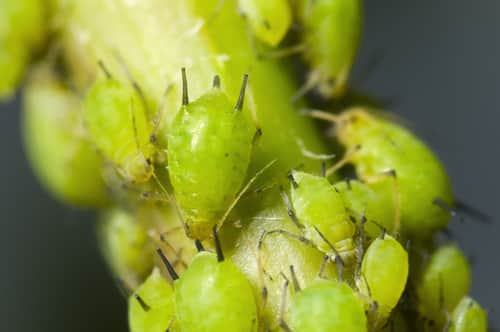
What do aphids look like on bonsai?
Aphids are typically green, black, tan, or yellow insects. They are an eighth of an inch in size. Most do not fly although some species can be found with wings. When viewed from the top down it appears as though their legs are protruding from their body.
How do aphids attack bonsai?
Aphids attack bonsai through the leaves. They usually puncture and weaken the leaves with their stylets, ingesting the liquids and nutrients from within.
What damage do aphids cause on bonsai?
Damaged, crinkled leaves which start to fall off, damaged flowering, yellowing leaves and browned tips on the leaves of your bonsai are the main damage aphids cause to bonsai. Aphids in large populations can also stunt plant growth and transmit mold and other viral diseases
Aphids can also secret a honeydew which can cause ants and other bigs to start infesting your bonsai.
What bonsai trees suffer from aphids the most?
Bonsai plant species with a lot of large leaves such as Maples or Ficus trees are much more likely to get aphids. This is because they have more room for aphids to hide in as well as a larger leaf surface area for aphids to feed on.
What bonsai trees suffer from aphids the least?
PIne plant species such as Aleppo or Bristlecone pine are less likely to suffer from aphids. This is because they have smaller leaves that are thinner in size making it more difficult for aphids to nest or feed on the leaves. Other succulents can also prove challenging for aphids.
Do larger bonsais get affected by aphids more?
Bonsais that are larger such as eight-handed emperor bonsai are more likely to suffer from aphids. This is because they are usually kept outdoors and will have a lot more leaves than smaller fingertip-sized bonsai.
For a full guide on Bonsai, size classification check out my post here.
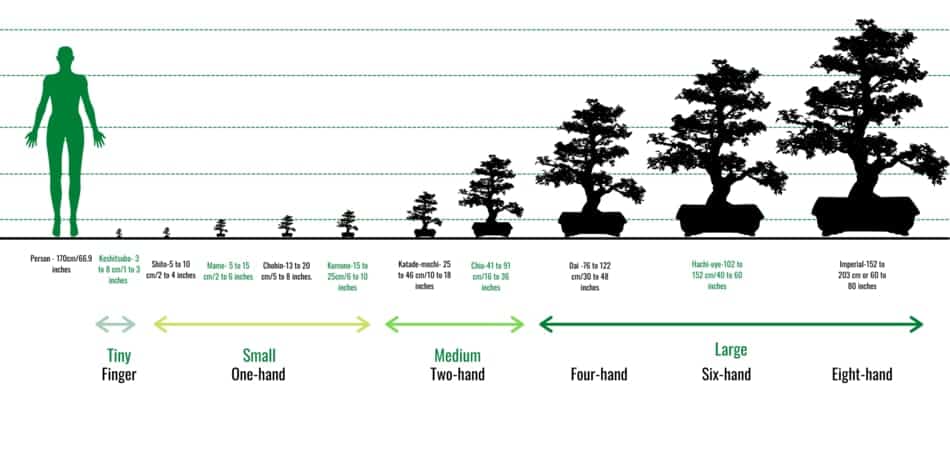
How to prevent aphids on bonsai going forward?
To prevent aphid infections going forward, inspect any new plants before bringing them home, keep your bonsai indoors, and set up a schedule where you check your bonsai leaves both top and bottom at least twice per week.
I’d also recommend spraying your bonsai with a soapy water mix once every two weeks in the summer months as a preventative measure. This will stop any aphid eggs from hatching.
What do the experts say about removing aphids from your bonsai?
Now whilst the above methods worked for me in getting rid of aphids, I also wanted to consult a few different experts on their methods of removing aphids.
This is what they said:
“Using a mix of soapy water or blasting aphids with water is probably the best method. Aphids in small number are fine so treat them when theta re small in number and you won’t have too much to worry about” Birmingham Botanical Gardens.
“It is not difficult to treat them with a bug spray that you will find at most garden centres”. Herons Bonsai
I also asked some of my readers about the methods they use to remove aphids from bonsai I got around 12 responses so here were the results:
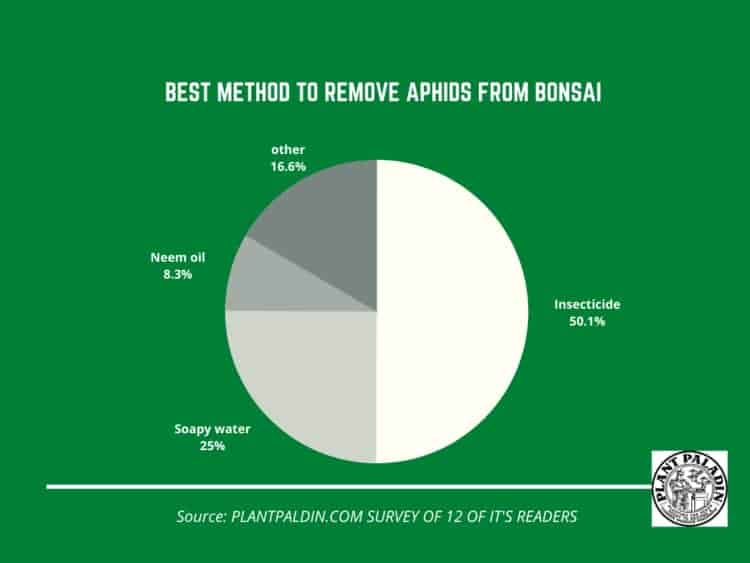
My top picks for the gear you will need!
So like I mentioned earlier, over the past three years of running PlantPaladin, hundreds of people have asked me for my recommendations on the best bonsai gear on the market.
Having spent thousands of dollars on bonsai items these past few years and tested at least 100 bonsai-specific products, I’ve listed my favorite products below – All of which I highly recommend and think you can get great value.
They can purchase directly by clicking the link to take them to Amazon.
Bonsai Tool Set: One of the significant challenges I’ve had is finding a toolset that was not only durable but didn’t break the bank. SOLIGT has recently developed a fantastic bonsai tool set that covers all the tools you need to trim, prune, and repot your trees. – You can grab it here.
Complete Bonsai Set: Many of you will want to grow your bonsai trees entirely from scratch, but finding the varicose seeds, pots, and other items in one place can be challenging. Leaves and Sole then have created a complete bonsai set that I’ve personally used that ticks all the boxes. You can grab it here.
Bonsai wire: The number of times I’ve run out of wire for my bonsai or purchased cheap bonsai wire that doesn’t do the job is embarrassing for me to admit. After a lot of trial and error, I found that using Hotop’s aluminum bonsai wire is one of the best options on the market. This can easily be used for both indoor and outdoor bonsai. You can grab it here.
This post was written by Fehed Nicass who has been passionate about bonsai for over 2 years.
